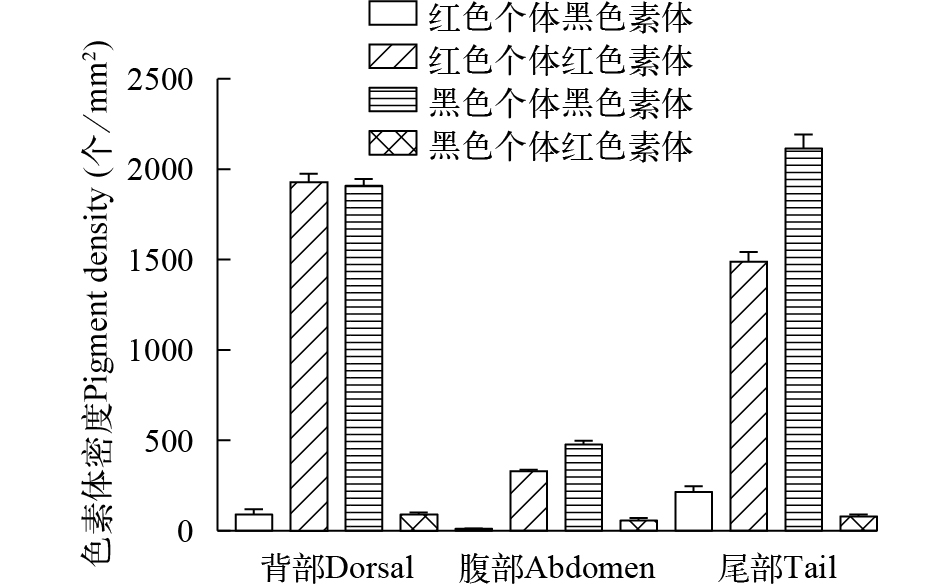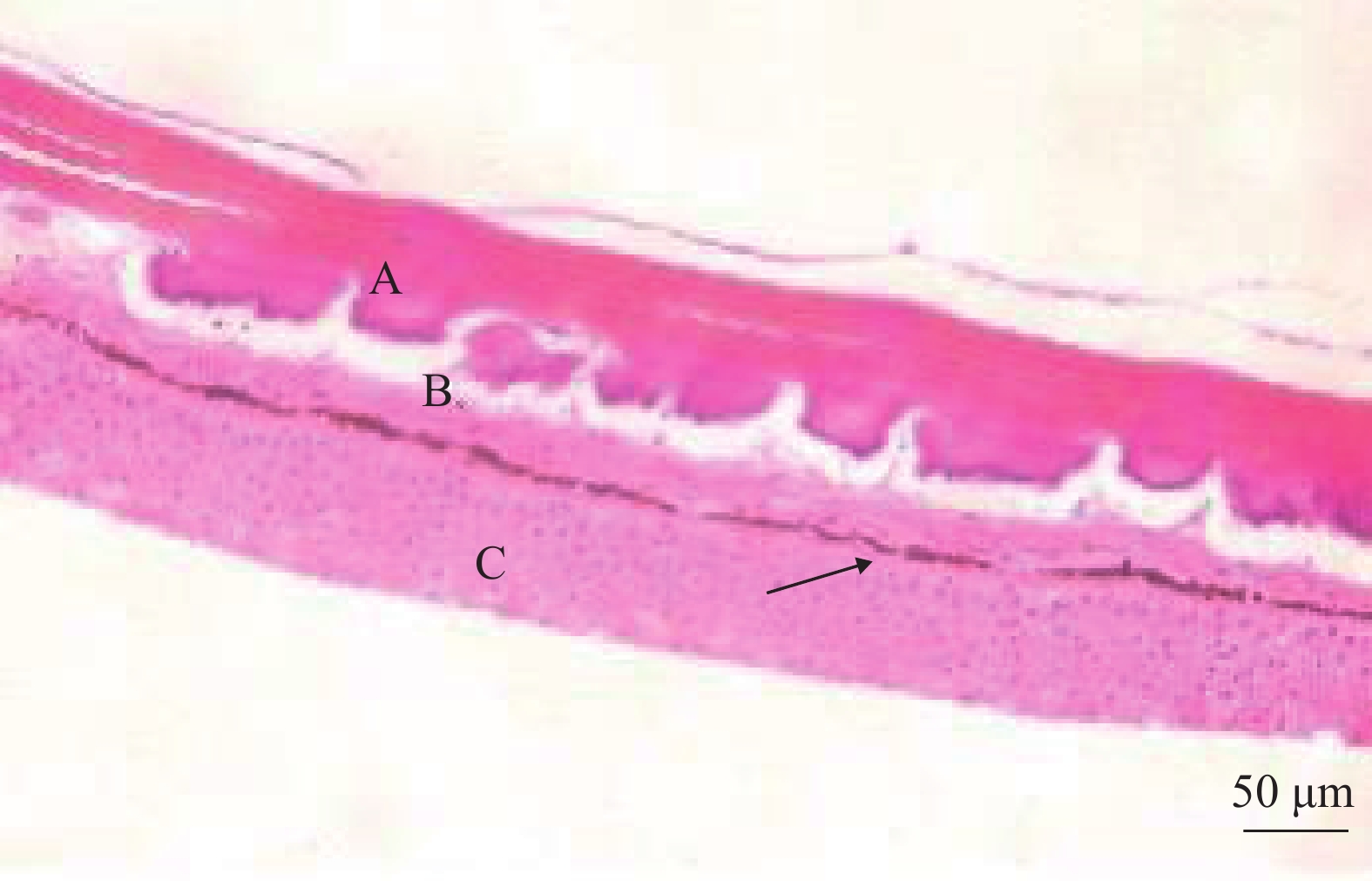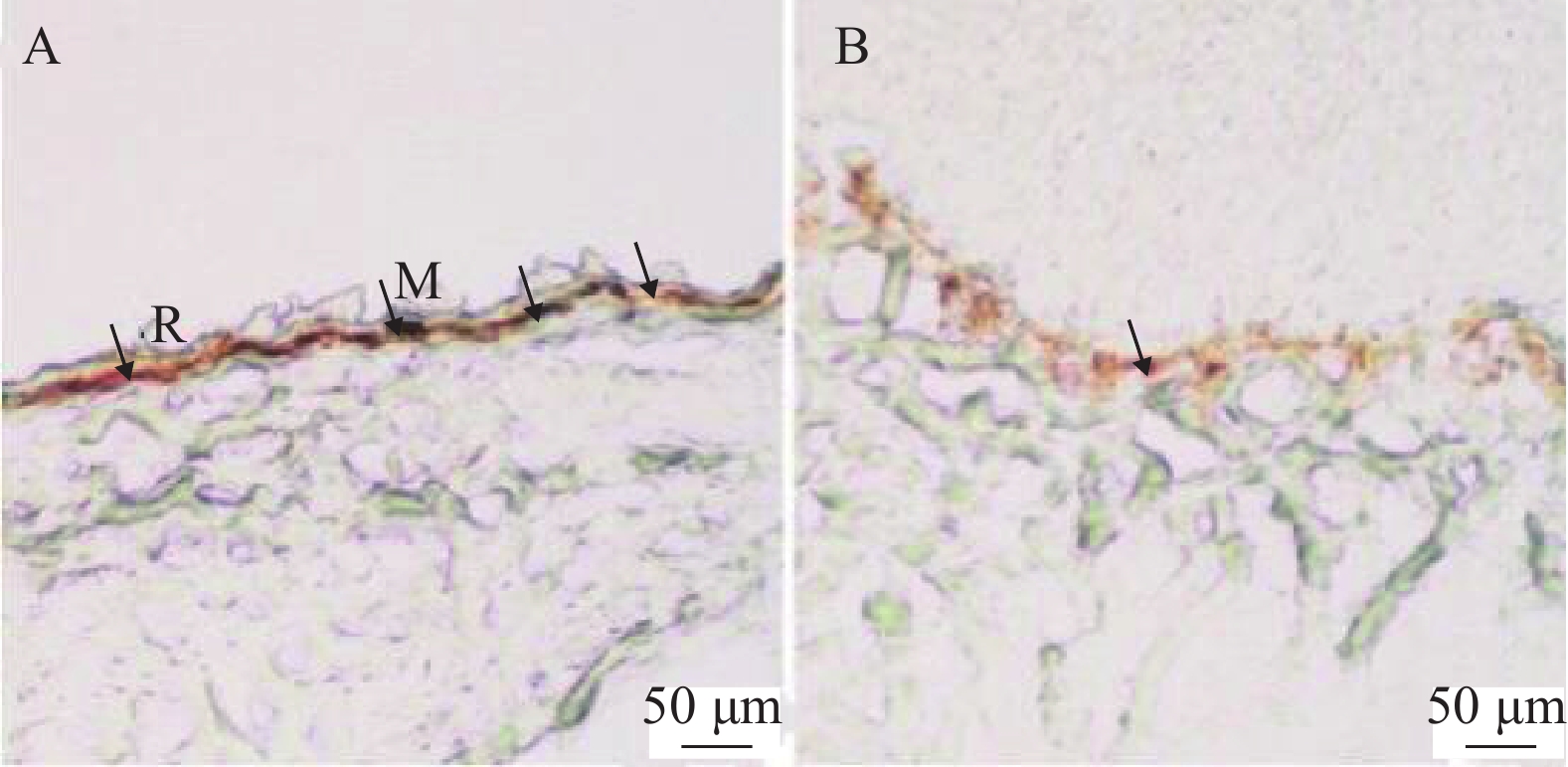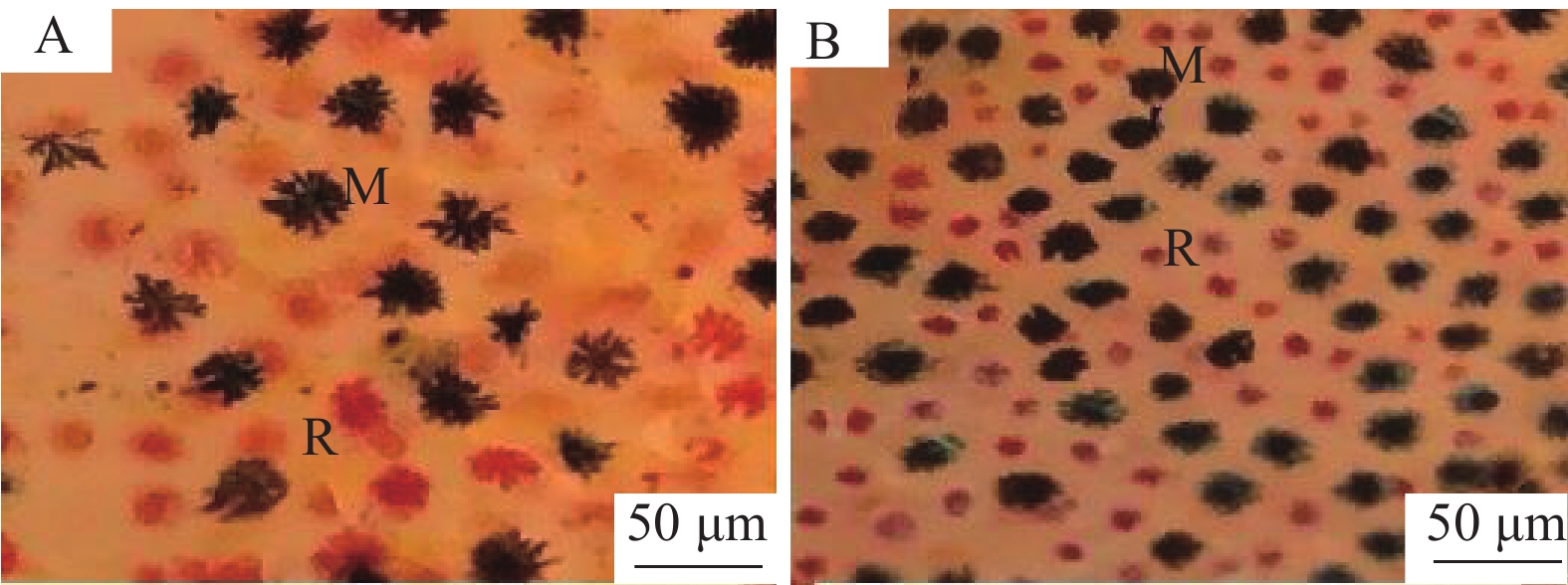ANALYSIS OF PIGMENT CELLS DIFFERENCE IN BODY COLOR VARIATION OF PLECTROPOMUS LEOPARDUS
-
摘要: 为了揭示豹纹鳃棘鲈(Plectropomus leopardus)体色变异机制, 研究选取了不同体色个体的样本, 利用石蜡切片、冰冻切片及体视显微镜观察等方法揭示不同皮肤部位色素细胞的类型、分布和数量的差异, 并对应激和非应激状态下色素细胞的变化进行了研究。结果显示, 黑色素细胞在背部和尾部分布比较密集, 在腹部较为稀疏, 黑色个体的黑色素细胞数量较红色个体多; 在应激状态下个体能迅速发生体色变化, 主要由于色素细胞快速扩张和收缩导致。研究为进一步揭示豹纹鳃棘鲈体色变异的分子机制和优良品种选育奠定了基础。Abstract: Body color is an unique phenotypic trait of fish, which is of great significance to the survival of species, avoiding enemy damage and preventing ultraviolet erosion. Coral reef fishes have rich species diversity and body color variation. Plectropomus leopardus, a coral reef fish, shows significantly different body colors in different environments. Its body color is gorgeous and bright, with high ornamental value and high economic value. Plectropomus leopardus is a valuable material to study the development and variation of body color. In order to reveal the mechanism of fish body color variation, Plectropomus leopardus individuals with different colors were selected. The skin color, types of pigment cells and movement state of pigment cells in different parts were observed by means of paraffin section, frozen section and stereoscopic microscope to compare the red and black Plectropomus leopardus. Then, the skin sections of the individuals with different colors were observed to analyze the influence of the number and distribution of pigment cells on the change of body color. Meanwhile, the difference of pigment cells between stress and non-stress groups was also studied. The results showed that the morphology of melanocytes and erythrocytes was mainly dendritic, and some are punctate. The size of melanocytes was 20—35 μm, and that of erythrocytes was 20—25 μm. In the black individuals, the back epidermis were mainly melanocytes, and the cells were zonal distribution. In the abdomen epidermis of the black individuals, a large number of melanocytes were observed. While in the tail of the black individuals, a large number of melanocytes were mainly distributed, the cell density was the largest, some cells were stacked distribution, and the tissue color was the deepest. In the red individuals, the dorsal epidermis was mainly composed of red pigment cells. In the abdominal epidermis, only red pigment cells were observed, with a small number of cells scattered in the tissues and the lightest color. In the tail of the red individuals, red pigment cells were widely distributed, with a block distribution, and a small number of melanocytes were observed in the tail epidermis. In the stress group, body color changed quickly and the granular pigment cells were smaller and darker than those in non-stress group, which was mainly due to the rapid expansion and contraction of pigment cells. This research will lay the foundation for further discovery of the development mechanism of body color formation of Plectropomus leopardus, and also provide theoretical guidance for the breeding.
-
Keywords:
- Plectropomus leopardus /
- Body color variation /
- Pigment cells /
- Stress /
- Frozen section
-
体色是鱼类形态多样性的特征之一, 鱼类的体色是由色素细胞及其所含的色素体产生的, 色素细胞的类型、大小、形态及分布的不同形成了丰富的体色, 为发育和进化提供了良好的材料[1]。鱼类皮肤包括黑色素细胞、红色素细胞、黄色素细胞和虹彩细胞等基本色素细胞[2]。鱼类体色相关基因的突变和缺失能够导致皮肤着色的异常[3], 体色也受神经系统和内分泌系统调节, 随着环境的改变而产生适应性变化[4, 5]。这种变化可以通过鳞片和皮肤中色素细胞内的色素体选择性地吸收特定波长的光而反射其他波长的光来完成[6]。鱼类在生长过程中, 会产生生理上的体色变化, 可以通过色素细胞的运动改变鱼类的体色[7-9], 同时也可通过色素细胞数量的增加或者减少对体色产生影响[10, 11]。鱼类在适应环境过程中, 光感受也会导致体色变化, 例如光照强度和光照周期等会影响内分泌系统对色素细胞生成代谢的调控[12]。
石斑鱼种类众多, 是全球珊瑚礁、海草场和海藻场生态系统的关键种, 不同种类的石斑鱼拥有着不同的体色, 丰富的体色变化为其提供了关键的伪装[13]。豹纹鳃棘鲈(Plectropomus leopardus)是一种主要分布于热带和亚热带海域的名贵礁栖石斑鱼, 其体色鲜艳呈红色, 全身布满蓝白色斑点, 既可作为观赏鱼类, 也可作为高食用价值的经济物种。然而, 豹纹鳃棘鲈的体色和斑纹会受到生理或环境因素的影响, 呈现出黑色和红色, 并在应激状态下发生颜色深浅的改变及斑纹的变异[14]。目前, 豹纹鳃棘鲈体色形成和变异的机理尚不明确, 因此, 深入探讨豹纹鳃棘鲈的体色调控规律, 探究其皮肤色素细胞的种类和分布, 及应激状态下色素细胞的变化, 将为探究其体色发育与变异的机制提供组织学的支撑。
本文以红色和黑色的豹纹鳃棘鲈为对象, 对其不同部位的皮肤进行组织学切片和观察, 揭示其色素细胞的组成、形态及分布规律, 并研究其受环境影响而产生应激状态下的色素细胞形态变化, 不仅能揭示石斑鱼类体色变异的多样性机制, 为培育优良体色的石斑鱼品种奠定理论基础, 也能够加深对于色彩丰富的珊瑚礁生态系统的理解。
1. 材料与方法
1.1 实验材料
本文的实验用鱼选自海南省琼海市鸿茂水产有限公司基地, 选取呈现体色差异的豹纹鳃棘鲈成鱼, 黑色和红色个体各30尾, 平均体重为(520.30±20.50) g, 平均每尾体长为(35.50±5.40) cm。
1.2 实验分组
本实验分为8组: 黑色鱼背部组(BB)、黑色鱼腹部组(BF)、黑色鱼尾部组(BW)、红色鱼背部组(RB)、红色鱼腹部组(RF)、红色鱼尾部组(RW)、红色鱼应激组(RS)和红色鱼非应激组(RE)。
1.3 体色观察
将鱼体擦拭干净后, 用相机(DSC-WX500)拍照, 并用色差仪(KONICA MINOLTA-CR-10Plus)对应激和非应激鱼体的背部、腹部和尾部进行测量, 色差仪使用标准白色板校准后测量样品颜色, 并输出比色后的色差数据。
剪下相同大小的黑色和红色豹纹鳃棘鲈第一背鳍到第二背鳍下方, 测线鳞上方的背部皮肤、腹鳍到臀鳍上方, 测线鳞下方的腹部皮肤和尾柄处皮肤, 用生理盐水润洗后, 在体视显微镜下观察, 利用五点取样法[15]进行色素体统计, 来计算平均单位面积下黑色素体和红色素体的数量, 从而得出色素体的密度。
1.4 石蜡切片
取豹纹鳃棘鲈的背部、腹部和尾部皮肤组织保存于Bouin氏液固定液中, 采用石蜡切片的方法, 经过脱水、透明、浸蜡、包埋、切片和展片、HE染色和封片等步骤后, 用组织切片扫描仪(Pannoramic MIDI)进行扫描和光学显微镜下观察。
1.5 冰冻切片
取豹纹鳃棘鲈的尾部皮肤保存于4%多聚甲醛24h, 经过蔗糖溶液脱水、OCT包埋和切片等步骤制成冰冻切片, 切片厚8—10 μm, 将组织贴于载玻片上, –20℃保存备用。
1.6 应激和非应激状态处理
豹纹鳃棘鲈被捕捞即发生应激反应, 皮肤斑纹出现显著变化, 为应激组; 在水体中缓慢加入鱼用麻醉剂(MS-222), 麻醉后再捞出, 豹纹鳃棘鲈体色和斑纹不改变, 为非应激组。用剪刀将2组鱼体的背部、腹部和尾部剪下面积为1 cm×1 cm, 厚度为2 mm的皮肤组织, 用PBS清洗后制作成装片置于体视镜(Motic SMZ-168)下观察。
2. 结果
2.1 豹纹鳃棘鲈体色差异分析
豹纹鳃棘鲈在应激状态下呈现出快速的体色变化, b、d个体为非应激状态, 分别呈现出较黑和较红的体色, 个体体色较深, 颜色分布均匀(图 1)。在应激条件下, 3—5s即可发生变化, 色素体在不同的部位收缩情况有较大差异, 呈现出明显的斑纹(a、c个体), 在侧线上方黑色个体和红色个体分别平均分布着黑色斑点和红色斑点, 均围绕着鱼体的蓝点分布, 斑点的大小和颜色没有明显差异, 其他部位皮肤颜色偏白, 斑点和其他部位皮肤颜色有着显著深浅差异。而鳍条变化程度较低, 颜色变浅, 尾鳍和臀鳍呈现出斑块状花纹。测线下方的腹部皮肤呈现条带状斑块, 皮肤颜色较背部更深。
利用色差仪分别对不同的身体部位进行色差分析, 得出豹纹鳃棘鲈的背部和尾部颜色较深, 腹部颜色较浅。如表 1所示, 在红色个体中非应激状态下的背部色差值显著高于应激状态, 在黑色个体中非应激状态下的背部和腹部色差值显著高于应激状态, 在应激状态下红色个体的背部和腹部色差值显著高于黑色个体; 在非应激状态下红色个体的背部和尾部色差值显著高于黑色个体。通过对不同体色豹纹鳃棘鲈色素细胞数量的观察得出(图 2), 在黑色个体中, 黑色素体的分布较红色个体更密; 在红色个体中, 仅存在少量的黑色素细胞。
表 1 豹纹鳃棘鲈皮肤色差值比较Table 1. Comparison of color difference of Plectropomus leopardus皮肤部位
Skin region红色个体
Red individual黑色个体
Black individual应激状态 非应激状态 应激状态 非应激状态 背部Dorsal 43.80b 63.23a 26.00c 47.50b 腹部Abdomen 21.77a 19.57ab 12.80b 22.83a 尾部Tail 61.23ab 59.47a 52.2a 50.07b 注: 上标不同字母之间表示存在显著性差异(P<0.05); 表格所示结果为总色差Note: Different superscript letters indicate significant differences (P<0.05). The result shown in the table is the total color difference 2.2 豹纹鳃棘鲈皮肤黑色素细胞组织学分析
观察豹纹鳃棘鲈的皮肤石蜡切片(图 3)可以得出, 皮肤的表皮层是由5—8层上皮细胞组成, 色素细胞主要分布于真皮层中, 色素细胞平行于表皮层排列紧密, 形成一条连续的色素条带。
分别观察豹纹鳃棘鲈的红色和黑色个体不同部位的皮肤切片(图 4), 可以得出不同部位的皮肤黑色素细胞的分布数量也不相同。背部和尾部皮肤黑色素细胞密度比较大, 腹部的黑色素细胞数量较少; 对不同体色豹纹鳃棘鲈的腹部进行观察, 可以得出黑色个体的黑色素细胞呈块状聚集在一起, 而红色个体的黑色素细胞分布比较稀疏; 观察尾部皮肤, 可以看出黑色个体的黑色素细胞连续分布, 数量显著多于红色个体, 而红色个体的黑色素细胞则局部分散于尾部。
![]() 图 4 豹纹鳃棘鲈皮肤组织切片显微结构A. 红色个体背部切片; B. 红色个体腹部切片; C. 红色个体尾部切片; D. 黑色个体背部切片; E. 黑色个体腹部切片; F. 黑色个体尾部切片; M. 色素细胞Figure 4. Microscopical observation on skin section of Plectropomus leopardusA. red individual back section; B. red individual abdomen section; C. red individual tail section; D. black individual back section; E. black individual abdomen section; F. black individual tail section; M. melanocytes
图 4 豹纹鳃棘鲈皮肤组织切片显微结构A. 红色个体背部切片; B. 红色个体腹部切片; C. 红色个体尾部切片; D. 黑色个体背部切片; E. 黑色个体腹部切片; F. 黑色个体尾部切片; M. 色素细胞Figure 4. Microscopical observation on skin section of Plectropomus leopardusA. red individual back section; B. red individual abdomen section; C. red individual tail section; D. black individual back section; E. black individual abdomen section; F. black individual tail section; M. melanocytes观察不同体色豹纹鳃棘鲈皮肤冰冻切片可得出(图 5), 黑色豹纹鳃棘鲈的尾部中含有大量的黑色素细胞和红色素细胞, 相间分布。在红色豹纹鳃棘鲈的尾部皮肤中, 可以明显观察到大面积分布的红色素体, 几乎不存在黑色素细胞。尾部皮肤组织中不仅色素细胞数量存在较大差异, 色素细胞的分布也存在差异, 在黑色个体中, 色素细胞平行于表皮基底层分布; 在红色个体中, 色素细胞呈现不规则分布。
2.3 豹纹鳃棘鲈应激和非应激状态下色素细胞观察
对豹纹鳃棘鲈在应激状态和非应激状态下的观察可以发现, 应激状态时体色会迅速变浅, 如图 6,通过体视镜显微观察可以发现不同状态下色素细胞的形态。
![]() 图 6 非应激状态和应激状态下的豹纹鳃棘鲈表皮色素体A. 非应激状态下色素细胞分布; B. 应激状态下色素细胞分布; M. 黑色素体; R. 红色素体Figure 6. Microscopic observation results of the Plectropomus leopardus in unstress state and stress stateA. Distribution map of pigment cells in unstress state; B. distribution map of pigment cells in stress state; M. melanosome; R. red pigment
图 6 非应激状态和应激状态下的豹纹鳃棘鲈表皮色素体A. 非应激状态下色素细胞分布; B. 应激状态下色素细胞分布; M. 黑色素体; R. 红色素体Figure 6. Microscopic observation results of the Plectropomus leopardus in unstress state and stress stateA. Distribution map of pigment cells in unstress state; B. distribution map of pigment cells in stress state; M. melanosome; R. red pigment在非应激状态下, 大多数的红色素细胞和黑色素细胞为树突状、散射状, 少数细胞形态为点状。在非应激状态下色素细胞体积较大、颜色较浅。其中, 黑色素细胞大小为20—35 μm, 红色素细胞相较于黑色素细胞较小为20—25 μm。在应激状态下, 色素细胞体积较小、颜色较深, 呈点状、团块状分布, 细胞为圆形或椭圆形。其中, 黑色素细胞大小为15—30 μm, 红色素细胞较小为10—15 μm。
3. 讨论
3.1 色素细胞与豹纹鳃棘鲈体色的关系
鱼类的体色呈现出多样性, 这主要是由色素细胞及其色素体的的分布、数量和种类决定的, 在大口黑鲈(Micropterus salmoides)、罗非鱼(Tilapia)鳃细胞和斑马鱼(Brachydanio rerio var)幼鱼中黑色素细胞主要分布在真皮层的疏松层中[16]。在黄颡鱼(Pelteobagrus fulvidraco)的色素细胞迁移和分化研究中, 在表皮上也提取出了黑色素细胞[17]; 通过透射电子显微镜发现匙吻鲟(Polyodon spathula)在表皮和真皮中均可观察到色素体, 其黑色素细胞为圆形或不规则, 可以自由流动[18]。这说明色素细胞在表皮层和真皮层中均可分布。本实验通过对红色和黑色豹纹鳃棘鲈不同部位进行组织学观察, 其皮肤主要可以分为表皮层和真皮层, 其色素细胞均分布于真皮层的疏松层中, 与大口黑鲈和罗非鱼中色素细胞的分布特征较为一致。
当鱼类受到环境因子[19]、饲料[20]和基因遗传等因素的影响[21]时, 体色会通过色素细胞的种类、大小、形状、数量和排列方式[22]及色素细胞的比例和色素小体的分布发生改变[23, 24]。本实验通过观察豹纹鳃棘鲈的皮肤得出不同部位的色素细胞数量存在着显著的差异, 其中背部和尾部黑色素细胞分布较多, 呈现出明显的色素条带, 而腹部色素细胞数量较少, 呈团块状分布, 并且在红色的豹纹鳃棘鲈中, 红色素细胞的比例显著高于黑色的豹纹鳃棘鲈。在对不同鱼类的研究中发现, 随着鱼体的发育,色素细胞的类型也会发生改变, 当色素细胞聚集在一起时,鱼类体表就会出现色素条带和斑块[25]。已有的研究发现, 在红、蓝和金属色系的暹罗斗鱼(Betta splendens Regan)中, 影响红色系深浅的关键因素是红、黄色素细胞的比例, 当黑色素细胞越多, 鱼体体色越深[26]。橘色双冠丽鱼(Amphilophus citrinellus)的体色鲜艳程度在发育过程中和其色素细胞数量变化是一致的, 黑色素细胞的减少及黄色素细胞和红色素细胞的增多有可能和鱼体体色变浅相关, 不同种类色素细胞的比例和分布有可能导致鱼类体色的变化[27]。这与本实验中不同体色豹纹鳃棘鲈红色素细胞和黑色素细胞比例存在差异的现象一致, 因此, 鱼体不同部位的呈色程度受到色素细胞数量的影响, 呈色较深的部位色素细胞数量多, 分布密集。该实验结果中不同部位色素细胞的分布差异可能与豹纹鳃棘鲈生长过程中规避敌害和自我保护有关, 其腹部色素细胞较少呈色较浅有利于自我隐蔽, 而背部和尾部色素细胞较多呈色较深可能与皮肤中感光调节有关。
3.2 在应激状态下豹纹鳃棘鲈的体色变化
两栖动物及其他的变色动物的体色改变, 主要是由于色素细胞及色素体的分布不同而导致的[28], 包括色素体的聚集和分散, 使得皮肤的颜色发生改变[11]。通过观察得到豹纹鳃棘鲈的皮肤中主要有红色素细胞和黑色素细胞, 其中呈树突状的黑色素细胞大量分布在体表。色素细胞的体积影响着其细胞分支, 体积越大, 色素细胞分支越多, 则含有更多的色素小体, 使得皮肤颜色加深[29]。例如在尼罗罗非鱼(Oreochromis niloticus)的研究中, 通过使用低剂量的MCH使黑色素细胞分支增多, 从而加深了鱼的体色[30]。这和本实验的研究结果相一致, 豹纹鳃棘鲈色素体聚集会导致色素在皮肤上的覆盖度显著降低, 从而呈现浅色; 而色素体的分散使得覆盖度增加, 导致表观体色加深。
一些鱼类所处环境改变或应激时, 其体表的色素细胞会发生聚集或分散, 当色素细胞分散时鱼的体色会变深, 而当色素细胞聚集时, 鱼的体色会变浅[31, 32]。在本实验研究结果中, 豹纹鳃棘鲈在环境条件发生改变时能够迅速变为应激状态, 黑色素细胞和红色素细胞变小呈颗粒状聚集在一起, 使得鱼的体色变浅。有关研究结果表明, 雄性雨蛙(Litoria wilcoxii)在抱合期间经历从棕色到黄色的快速颜色变化, 并在被捕获后逐渐失去黄色, 这可能是受到外界压力后黑色素细胞移位的结果[11]。在大口黑鲈的研究中发现, 色素细胞膨大时, 色素展开, 体色格外鲜明, 而当色素细胞收缩时, 色素隐没, 体色亦随之黯淡或隐没[16]。在大黄鱼(Larimichthys crocea)的相关研究中表明, MSH多肽可以分散大黄鱼的黄色素细胞, 使其体色缓慢变黄[33]。比目鱼(Pleuronectiformes)能够相当逼真地与多种环境相匹配, 调整体表斑块, 其变色时间为2—8s[34]。综上所述, 豹纹鳃棘鲈的体色变化原因与已有报道一致, 是由色素细胞的形态导致。然而当豹纹鳃棘鲈受到外界环境的刺激时, 可能由神经调控其红色素细胞和黑色素细胞色素体发生迅速的运动, 使背部和腹部呈现出不同的斑纹和颜色, 可能与珊瑚礁鱼类躲避敌害有关, 3—5s即可完成变化, 其体色变化的速度与其他鱼类存在显著差异。
-
图 4 豹纹鳃棘鲈皮肤组织切片显微结构
A. 红色个体背部切片; B. 红色个体腹部切片; C. 红色个体尾部切片; D. 黑色个体背部切片; E. 黑色个体腹部切片; F. 黑色个体尾部切片; M. 色素细胞
Figure 4. Microscopical observation on skin section of Plectropomus leopardus
A. red individual back section; B. red individual abdomen section; C. red individual tail section; D. black individual back section; E. black individual abdomen section; F. black individual tail section; M. melanocytes
图 6 非应激状态和应激状态下的豹纹鳃棘鲈表皮色素体
A. 非应激状态下色素细胞分布; B. 应激状态下色素细胞分布; M. 黑色素体; R. 红色素体
Figure 6. Microscopic observation results of the Plectropomus leopardus in unstress state and stress state
A. Distribution map of pigment cells in unstress state; B. distribution map of pigment cells in stress state; M. melanosome; R. red pigment
表 1 豹纹鳃棘鲈皮肤色差值比较
Table 1 Comparison of color difference of Plectropomus leopardus
皮肤部位
Skin region红色个体
Red individual黑色个体
Black individual应激状态 非应激状态 应激状态 非应激状态 背部Dorsal 43.80b 63.23a 26.00c 47.50b 腹部Abdomen 21.77a 19.57ab 12.80b 22.83a 尾部Tail 61.23ab 59.47a 52.2a 50.07b 注: 上标不同字母之间表示存在显著性差异(P<0.05); 表格所示结果为总色差Note: Different superscript letters indicate significant differences (P<0.05). The result shown in the table is the total color difference -
[1] Storebakken T, No H K. Pigmentation of rainbow trout [J]. Elsevier, 1992, 100(1-3): 209-229.
[2] Kelsh R N. Genetics and evolution of pigment patterns in fish [J]. Pigment Cell Research, 2010, 17(4): 326-336.
[3] 刘力, 裴思然, 吴华丽, 等. 基于tyrp1a转基因斑马鱼构建色素障碍性疾病药物筛选模型 [J]. 中国药科大学学报, 2016, 47(6): 740-743. Liu L, Pei S R, Wu H L, et al. Drug screening model of treating pigmentation disorders in tyrp1a transgenic zebrafish [J]. Journal of China Pharmaceutical University, 2016, 47(6): 740-743.
[4] Hee C S, Hoon K B, Hoon L C, et al. Response of body color change rearing under different light intensity conditions in farmed red spotted grouper, Epinephelus akaara [J]. Fisheries and Aquatic Sciences, 2020, 23(1): 1-9. doi: 10.1186/s41240-020-0147-y
[5] Kasagi S, Miura M, OkazakiT, et al. Effects of tank color brightness on the body color, somatic growth, and endocrine systems of rainbow trout Oncorhynchus mykiss [J]. General and Comparative Endocrinology, 2020(298): 113581.
[6] 徐伟, 李池陶, 曹顶臣, 等. 几种鲤鲫鳞片色素细胞和体色发生的观察 [J]. 水生生物学报, 2007, 31(1): 67-72. doi: 10.3321/j.issn:1000-3207.2007.01.010 Xu W, Li C T, Cao D C, et al. Observation on scale chromatophore and body color’s genesis of carp and cruscian carp [J]. Acta Hydrobiologica Sinica, 2007, 31(1): 67-72. doi: 10.3321/j.issn:1000-3207.2007.01.010
[7] Liu J, Zhang Y, Gui S, et al. Observation and regression models on body colour inheritance and development in crucian carp and carp [J]. Aquaculture International, 2016, 24(4): 1191-1199. doi: 10.1007/s10499-016-9979-y
[8] Parichy D M, Johnson S L. Zebrafish hybrids suggest genetic mechanisms for pigment pattern diversification in Danio [J]. Development Genes and Evolution, 2001, 211(7): 319-328. doi: 10.1007/s004270100155
[9] Hoekstra H E. Genetics, development and evolution of adaptive pigmentation in vertebrates [J]. Heredity, 2006, 97(3): 222-234. doi: 10.1038/sj.hdy.6800861
[10] Nilsson S H, Aspengren S, Wallin M. Rapid color change in fish and amphibians-function, regulation, and emerging applications [J]. Pigment Cell & Melanoma Research, 2013, 26(1): 29-38.
[11] Kindermann C, Hero J. Pigment cell distribution in a rapid colour changing amphibian (Litoria wilcoxii) [J]. Zoomorphology, 2016, 135(2): 197-203. doi: 10.1007/s00435-016-0303-1
[12] 马本贺, 孙志宾, 马爱军, 等. 环境光色对白条双锯鱼幼鱼生长和体色的影响 [J]. 海洋与湖沼, 2017, 48(1): 148-154. Ma B H, Sun Z B, Ma A J, et al. Effect of light color on growth and body color in tomato clownfish Amphiprion frenatus juvenile [J]. Oceanologia et Limnologia Sinica, 2017, 48(1): 148-154.
[13] 丁少雄, 刘巧红, 吴昊昊, 等. 石斑鱼生物学及人工繁育研究进展 [J]. 中国水产学, 2018, 25(4): 737-752. doi: 10.3724/SP.J.1118.2018.18110 Ding S X, Liu Q H, Wu H H, et al. A review of research advances on the biology and artificial breeding of groupers [J]. Journal of Fishery Sciences of China, 2018, 25(4): 737-752. doi: 10.3724/SP.J.1118.2018.18110
[14] 周邦维, 李勇, 高婷婷, 等. 主要营养素源对工业化养殖豹纹鳃棘鲈生长、体色和消化吸收的影响 [J]. 动物营养学报, 2014, 26(5): 1387-1401. doi: 10.3969/j.issn.1006-267x.2014.05.033 Zhou B W, Li Y, Gao T T, et al. Effects of main nutrient element and source on growth, body color, digestion and absorption of Plectropomus leopardus in industrialized culture [J]. Chinese Journal of Animal Nutrition, 2014, 26(5): 1387-1401. doi: 10.3969/j.issn.1006-267x.2014.05.033
[15] 田宗秀, 密守军. “采集和测算空气中的尘埃粒子”的教学设计 [J]. 生物学通报, 2012, 47(9): 22-25. doi: 10.3969/j.issn.0006-3193.2012.09.008 Tian Z X, Mi S J. A teaching design for collecting and measuring dust particles in the air [J]. Bulletin of Biology, 2012, 47(9): 22-25. doi: 10.3969/j.issn.0006-3193.2012.09.008
[16] 程辉辉, 刘新华, 涂尹, 等. 大口黑鲈、罗非鱼鳃弓色素颗粒的初步观察 [J]. 当代水产, 2013(5): 89-90. doi: 10.3969/j.issn.1674-9049.2013.05.027 Cheng H H, Liu X H, Tu Y, et al. Preliminary observation of pigment particles in gill bow of Micropterus salmoides and Tilapia [J]. Current Fisheries, 2013(5): 89-90. doi: 10.3969/j.issn.1674-9049.2013.05.027
[17] 程炜轩, 许国焕, 熊达, 等. 黄颡鱼黑色素细胞原代培养及迁移相关基因克隆分析 [J]. 生态毒理学报, 2014, 9(6): 1035-1040. Cheng W X, Xu G H, Xiong D, et al. Primary culturing of melanoma cells and cloning analysis of migrationrelated gene in Pelteobagrus fulvidraco [J]. Asian Journal of Ecotoxicology, 2014, 9(6): 1035-1040.
[18] Zarnescu O. Ultrastructure of the skin melanophores and iridophores in paddlefish, Polyodon spathula [J]. Micron, 2007, 38(1): 81-84. doi: 10.1016/j.micron.2006.03.015
[19] Bernatchez L. On the maintenance of genetic variation and adaptation to environmental change: considerations from population genomics in fishes [J]. Fish Biology, 2016, 89(6): 2519-2556. doi: 10.1111/jfb.13145
[20] 程炜轩, 许国焕, 张丽, 等. 氧化鱼油对黄颡鱼黑色素合成酶及内分泌激素的影响 [J]. 水生生物学报, 2017, 41(5): 1020-1026. doi: 10.7541/2017.127 Cheng W X, Xu G H, Zhang L, et al. Effects of dietary inclusion of oxidized fish oil on melanin, melanin synthetic enzymes and hormones of Pelteobagrus fulvidraco [J]. Acta Hydrobiologica Sinica, 2017, 41(5): 1020-1026. doi: 10.7541/2017.127
[21] Chen C, Wu L, Li Y, et al. Morphology of the early age and the pigment occurrence and the effects of different feed additives on the body color of Plectropomus leopardus [J]. Progress in Fishery Sciences, 2014, 35(5): 83-90.
[22] Mahalwar P, Singh A P, Fadeev A, et al. Heterotypic interactions regulate cell shape and density during color pattern formation in zebrafish [J]. Biology Open, 2016, 5(11): 1680-1690. doi: 10.1242/bio.022251
[23] Liang Y, Meyer A, Kratochwil C F. Neural innervation as a potential trigger of morphological color change and sexual dimorphism in cichlid fish [J]. Scientific Reports, 2020, 10(1): 12329. doi: 10.1038/s41598-020-69239-w
[24] 彭康康, 张博, 鲍宝龙, 等. 黑化牙鲆不同部位皮肤黑色素细胞和鳞片形态的比较 [J]. 上海海洋大学学报, 2019, 28(5): 708-715. doi: 10.12024/jsou.20190502632 Peng K K, Zhang B, Bao B L, et al. Comparative analysis of skin melanophore and scales in different parts of melanized Japanese flounder Paralichthys olivaceus [J]. Journal of Shanghai Ocean University, 2019, 28(5): 708-715. doi: 10.12024/jsou.20190502632
[25] 刘伟, 赵金良, 魏磊, 等. 鳜早期色素发育和色彩图案的形成 [J]. 动物学杂志, 2019(2): 236-244. Liu W, Zhao J L, Wei L, et al. The early pigmentation and color pattern formation of mandarin fish Siniperca chautsi [J]. Chinese Journal of Zoology, 2019(2): 236-244.
[26] 张希, 杨宁, 孙鶱, 等. 不同颜色品系暹罗斗鱼色素细胞的观察 [J]. 水产科技情报, 2014, 41(6): 290-293. Zhang X, Yang N, Sun X, et al. Observation of pigment cells in different color strains of Betta splendens Regan [J]. Fisheries Science and Technology Information, 2014, 41(6): 290-293.
[27] 蒋燕玲. 橘色双冠丽鱼体色发育变化及体色相关基因TYR的克隆与表达研究 [D]. 上海: 上海海洋大学, 2016: 1-65. Jiang Y L. Body color variation and cloning, expression analysis of TYR gene in Amphilophus citrinellus [D]. Shanghai: Shanghai Ocean University, 2016: 1-65.
[28] Zhang Y, Liu J, Peng L, et al. Comparative transcriptome analysis of molecular mechanism underlying gray-to-red body color formation in red crucian carp (Carassius auratus, red var.) [J]. Fish Physiology and Biochemistry, 2017, 43(5): 1387-1398. doi: 10.1007/s10695-017-0379-7
[29] 于道德, 刘洪军, 关健, 等. 黑棘鲷早期色素细胞发育与体色变化 [J]. 渔业科学进展, 2012, 33(5): 1-7. doi: 10.3969/j.issn.1000-7075.2012.05.001 Yu D D, Liu H J, Guan J, et al. Early ontogeny of chromatophores and body color changes of Acanthopagrus schlegelii [J]. Progress in Fishery Sciences, 2012, 33(5): 1-7. doi: 10.3969/j.issn.1000-7075.2012.05.001
[30] Oshima N, Nakamaru N, Araki S, et al. Comparative analyses of the pigment-aggregating and dispersing actions of MCH on fish chromatophores [J]. Comparative Biochemistry and Physiology, Part C
, 2001, 129(2): 75-84. [31] Takahashi A, Mizusawa K, Amano M. Multifunctional roles of melanocy testimulating hormone and melanin-concentrating hormone in fish: evolution from classical body color change [J]. Aqua-Bioscience Monographs, 2014, 7(1): 1-46. doi: 10.5047/absm.2014.00701.0001
[32] Sugimoto M. Morphological color changes in fish: regulation of pigment cell density and morphology [J]. Microscopy Research and Technique, 2002, 58(6): 496-503. doi: 10.1002/jemt.10168
[33] Han J, Hong W S, Wang Q, et al. The regulation of melanocyte-stimulating hormone on the pigment granule dispersion in the xanthophores and melanophores of the large yellow croaker (Larimichthys crocea) [J]. Aquaculture, 2019(507): 7-20.
[34] Ramachandran V S, Tyler C W, Gregory R L, et al. Rapid adaptive camouflage in tropical flounders [J]. Nature, 1996, 379(6568): 815-818. doi: 10.1038/379815a0
-
期刊类型引用(5)
1. 庾楚霞,郭华阳,林漪,刘宝锁,刘波,朱腾飞,张建设,张殿昌. 尖翅燕鱼早期色素细胞发育与体色变化. 南方水产科学. 2025(01): 96-104 .  百度学术
百度学术
2. 钱振家,徐金铖,张成林,余友斌,刘晃. 不同流速对豹纹鳃棘鲈摆尾频率和血液生理的影响. 南方水产科学. 2023(02): 89-97 .  百度学术
百度学术
3. 许振民,陈子钊,崔海涛,王中铎,郭昱嵩. 红鳍笛鲷皮肤色素细胞组成、分布及类胡萝卜素含量分析. 广东海洋大学学报. 2023(02): 36-42 .  百度学术
百度学术
4. 王梅,张永勤,黄靖,彭亮跃,刘文彬,肖亚梅,刘锦辉. 红斑马鱼体色观察及敲除mitfa基因对其体色发育的影响. 激光生物学报. 2022(01): 19-26 .  百度学术
百度学术
5. 刘鑫,康建平,林岗,缪凡,叶翚,饶小珍,钟传明. 东星斑循环水养殖系统的水体营养盐及微生物群落结构特征. 福建农业学报. 2022(06): 754-764 .  百度学术
百度学术
其他类型引用(8)




 下载:
下载:




